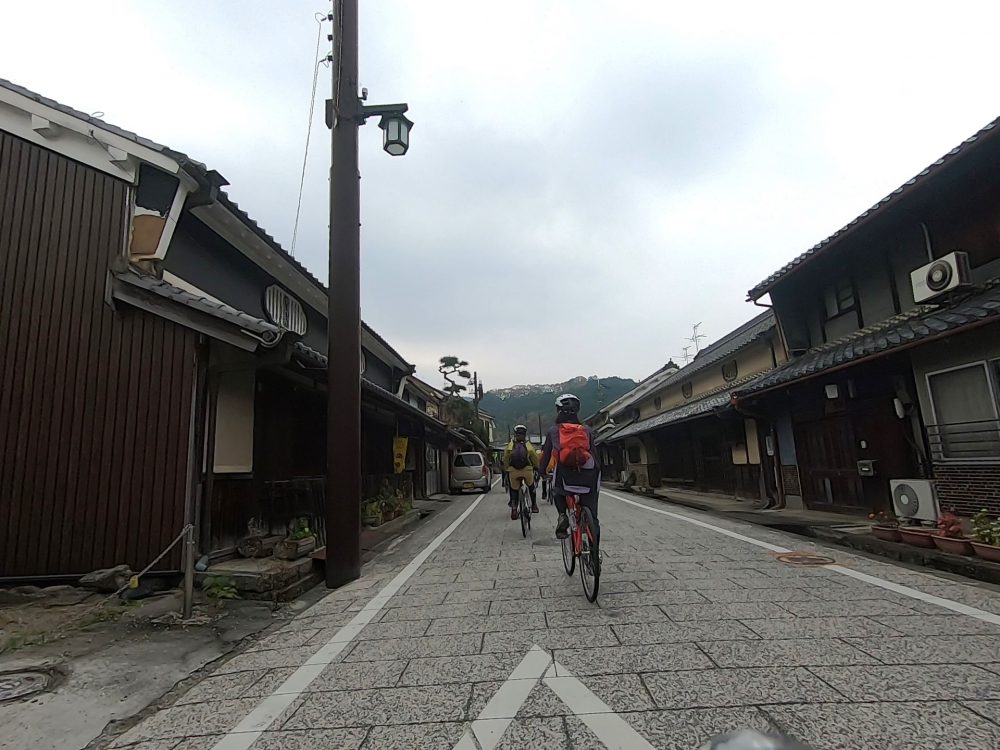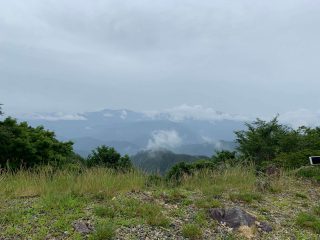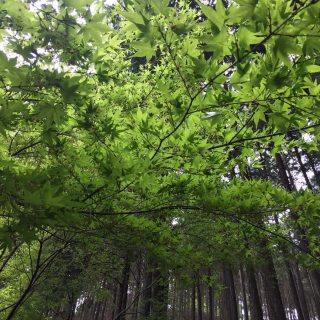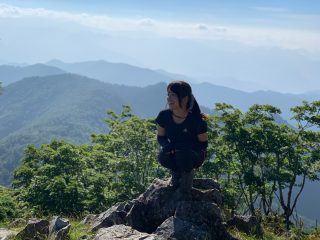The small village Asuka, located in Nara Prefecture is a location that should be on the top of the must-see list for anyone who has the slightest passing interest in the history of Japan or for that matter, the east asian region. In contrast to the neighboring, world-renowned metropolitan areas of Kyoto and Osaka, the area of Asuka can be described as basically just hilly countryside made up of terraced rice fields and separated by small clusters of homes. The one train line that runs through it offers no particular views of anything that might make the passerby think that it is a location of any particular importance or that, in fact, this sleepy town was once home to events that are considered essential to the formation of the world power now known as Japan during the Asuka Period of Japan.
Actually, I think “essential” might not due the Asuka area justice as there are a number of different places you could assign that term to, including the previously mentioned Osaka and Kyoto, with their plethora of examples of Japanese high-culture, including temples, shrines, castles, and so on. Rather, in my opinion, what sets Asuka apart is what its history can tell us about the different peoples and ideas that would lead to the eventual creation of the country. Asuka tells a part of the story of the diversity of Japan’s roots, from evidence of ancient nature worship practices to the introduction of new ways of thinking about the universe from abroad under a central government modeled after China’s dynastic court. This story takes many forms, including ancient, monolithic rocks carved into various shapes (the creators of which remain a mystery), to the oldest Buddhist temple grounds (Asuka-dera Temple) which gives us insight into what form the faith took when it was first introduced to Japan.
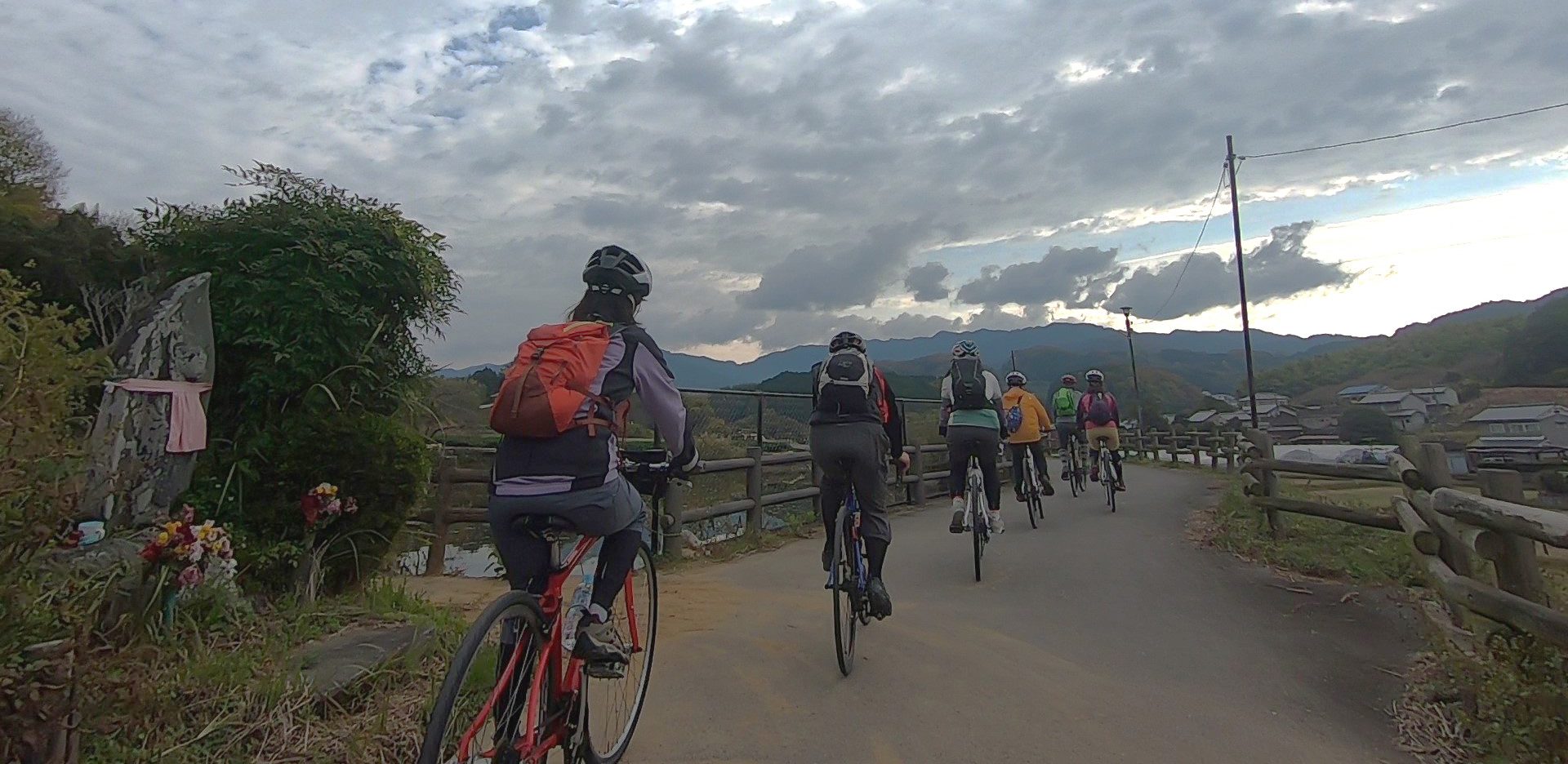
So, all of this is nice but how exactly, you might be asking yourself, can a visitor go about checking this very rural area out? Well, one good solution that locals have come up with is the bicycle tour. It is exceptionally easy to rent your own bicycle (no need to deal with troublesome automated machines and credit cards), from in front of Asuka Station; all you need to do is go directly to one of the shops located there, supply some basic info about yourself (bring your passport) and then you can be off to check out Asuka on your own; this is how I did it the first time I visited and it left such an impression on me that I vowed to myself to return someday if I could.
Getting around can be a bit confusing though, which is why it may be an even better idea to join a bicycle tour, one of which I was lucky enough to be invited to in November of 2019. This tour in particular was a full-day course operated by Niwa Cycling Tours which covered a wide variety of different important historical locations in Asuka. The following is a brief account of this tour along with my thoughts on the experience.
The Tour Experience
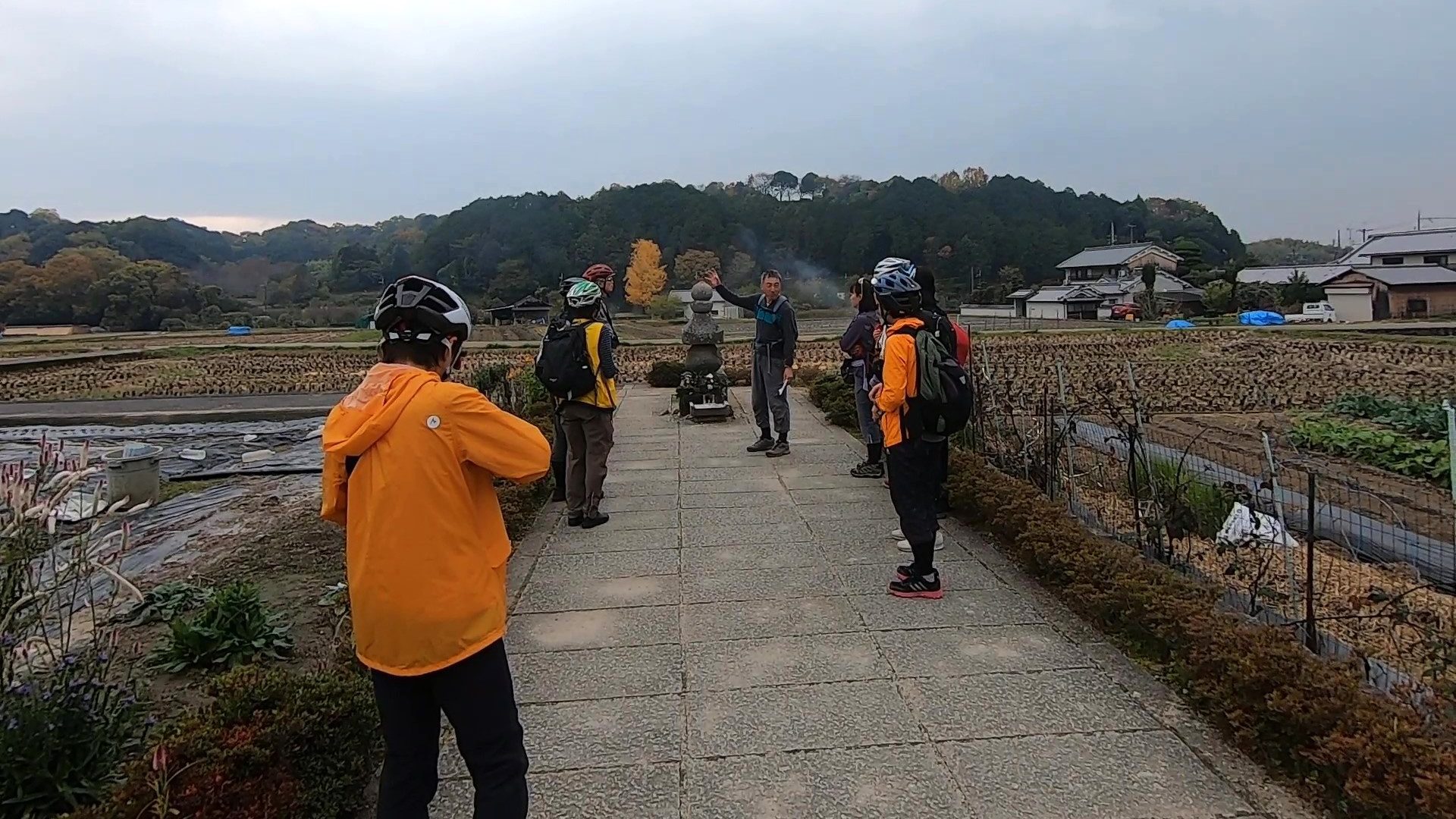
The tour group, led by Mr. Niwa (center right)
Meeting near Asuka Station, the tour I was to join was made up of about 10 other people, mostly visiting from the Kanto region of Japan and was led by experienced cyclist and guide, Mr. Niwa. The tour was actually a 3 day journey through Nara, and I was invited to join the last day, which was to take place in the village of Asuka. After doing my best to introduce myself in Japanese to the rest of the group, we set off through the countryside towards our first destination at a leisurely pace.
Getting comfortable on my cross bike, I was instantly reminded of the simple joy of what it was to ride a bike through this area again. Following the guide, we navigated winding, narrow paths past traditional-style homes and through sweeping vistas of agricultural area with patches of forest. The steep mountains surrounding the Nara Basin, which once sheltered and provide water to early Japanese civilization, made the perfect backdrop to an already lovely view. As I heard one fellow participant remark along the way, the landscape of Asuka has a very Japanese feel to it, combining the elements that make up a traditional image of Japan (rice fields, forests, small clusters of homes, and mountains).
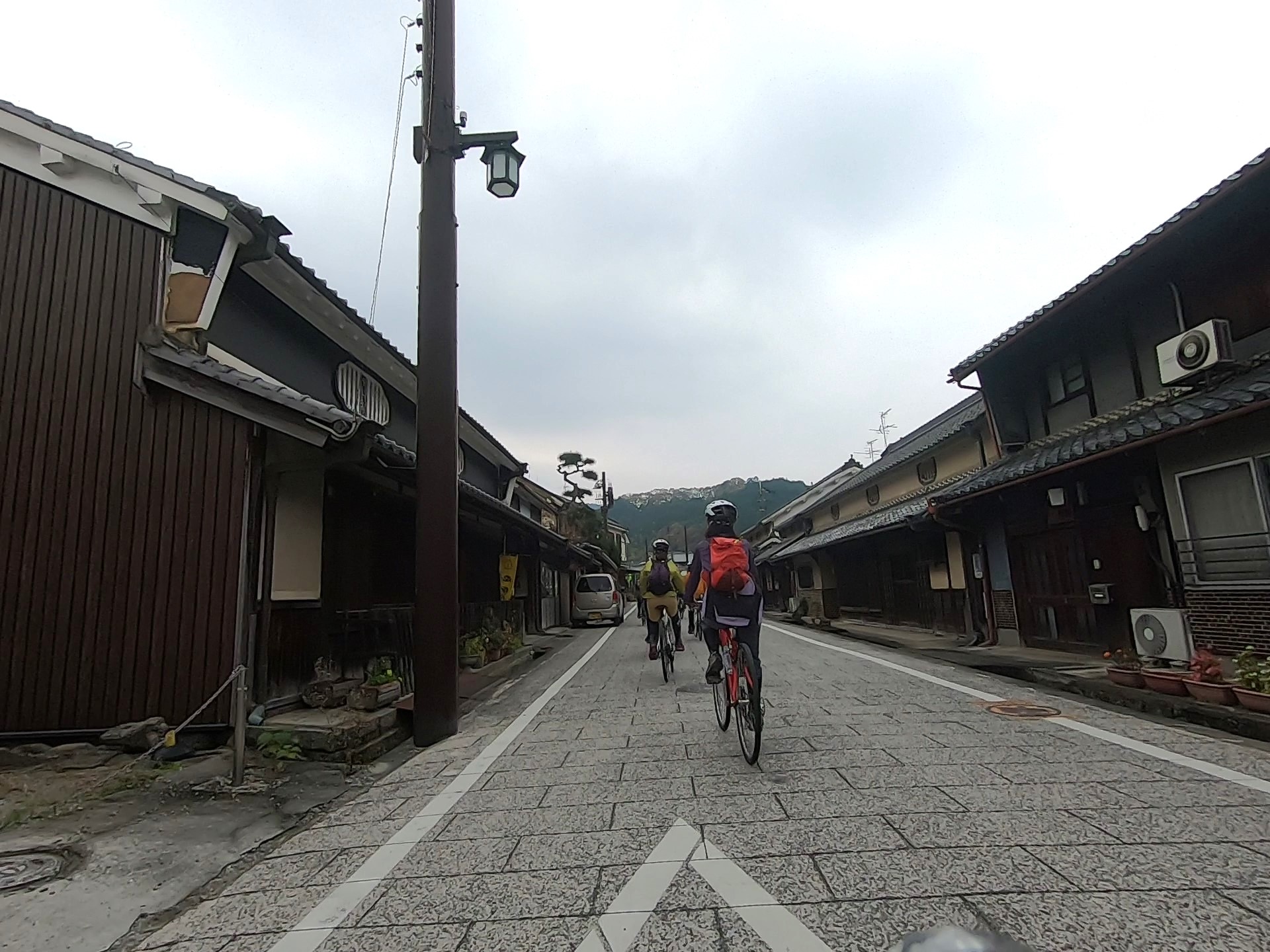
Asuka’s traditional streetscape.
The Mysterious Stone Objects
After riding for a bit we arrived at our first destination: the Monkey Stones or “Saru Ishi” of Asuka. Rediscovered buried deep in the earth several hundred years ago, these stones are now placed in a small group of trees located near an ancient key-hole shaped imperial burial mound (these burial mounds are also a common sight throughout Asuka).
The exact purpose of the Saru Ishi is unclear as no records exist about who created them or why, but it is fun to speculate. Their faces are all carved into different expressions that seem to be more human than animal, and in my opinion, and are all pretty jovial. Maybe they are ancient representations of nature gods of some kind? Or perhaps something much more mundane? Interestingly, these are also not the only Saru Ishi in the area, with the neighboring town of Takatori also containing a similar odd stone.
After seeing the Saru Ishi, we were guided on further to more odd stones of unclear origins. About halfway up a small hill, we stopped again and our guide made a remark about how if anybody needed to use the bathroom, now was the time to do it. I did not understand what he was talking about (or joking about, rather), until I saw the next stone: a giant rock with a rectangle-shaped space carved out of the middle of it. This was the “Oni-no-setchin” or Demon’s Toilet stone. Just as the name implies, this stone is legendarily reputed to have been used by ancient demons as a place to relieve themselves (I had no idea demons were so hygiene-conscious). This toilet was located nearby another big flat stone, known as the “Oni-no-manaita,” which is said to have served as a cutting board for humans unfortunate enough to have been captured and use for food by said demons. Apparently, the demonic creators must have wanted to cover the full cycle of food in this one area.
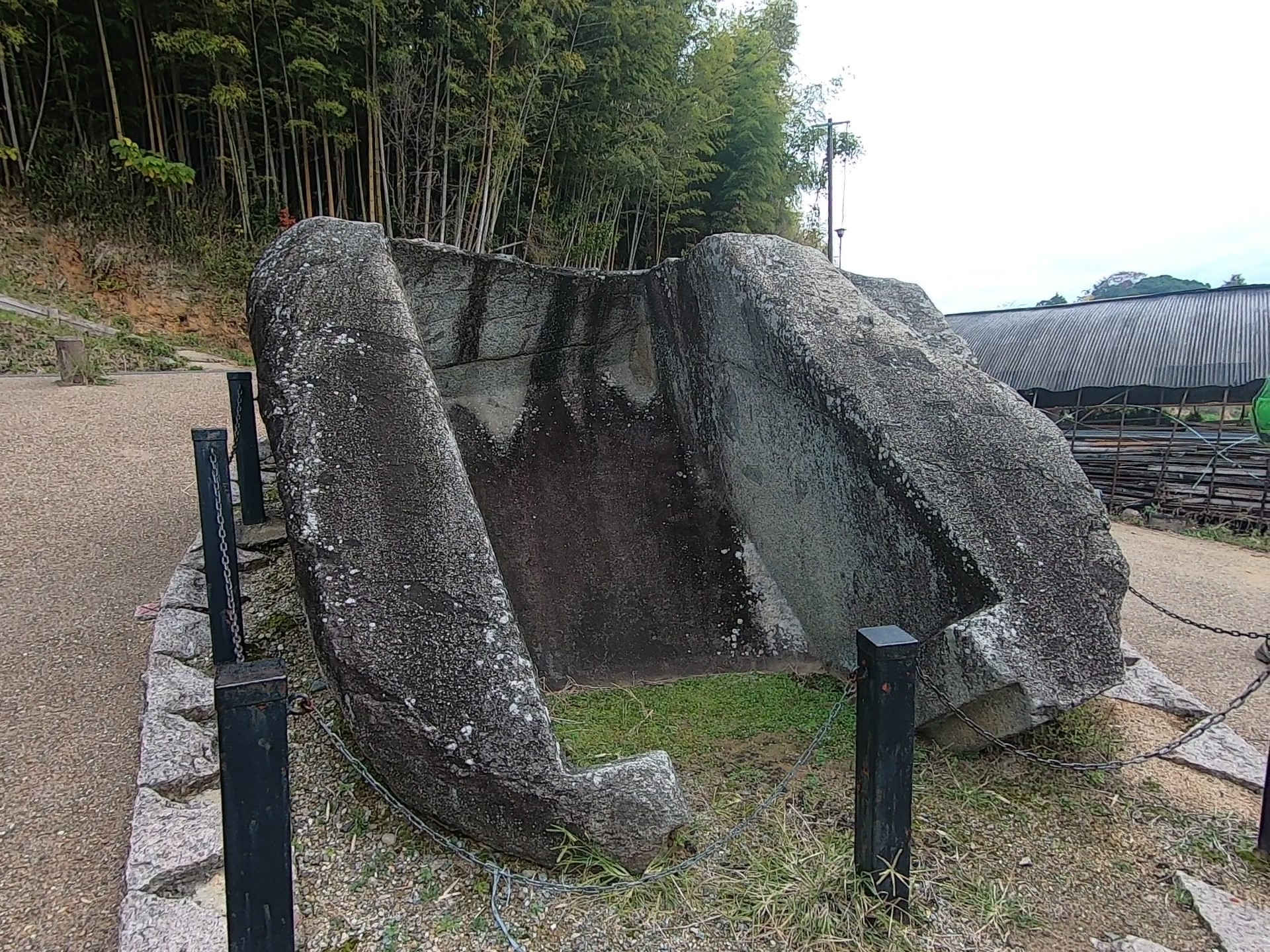
The Oni-no-sechin Demon’s Toilet. Located on a small hill, whoever built this seemed to be looking for a location with a view.
Stepping away from the legend a bit, a sign posted at the site states that historical research suggests that the Oni-no-setchin was part of an ancient tomb that fell apart long ago, with people later on attaching the legend of the demon’s toilet to the thing. Regardless, after one participant did the obligatory duty of taking a photo while pretending to use the toilet, we moved on.
The tour continued in much the same manner, with Mr. Niwa taking us to other fascinating monolithic stones, including Turtle Rock “Kame Ishi” and a phallic stone, “Mara-ishi,” which has its roots in ancient fertility beliefs, (just below this is “Fuguri-yama” or Testical Hill, to complete the set). I found that these stones all had a striking honesty and simplicity to them that seemed to speak of a bygone era of when we saw ourselves more in nature than we do now, though we still think in much the same way; in other words, their is a familiar humanity to them.
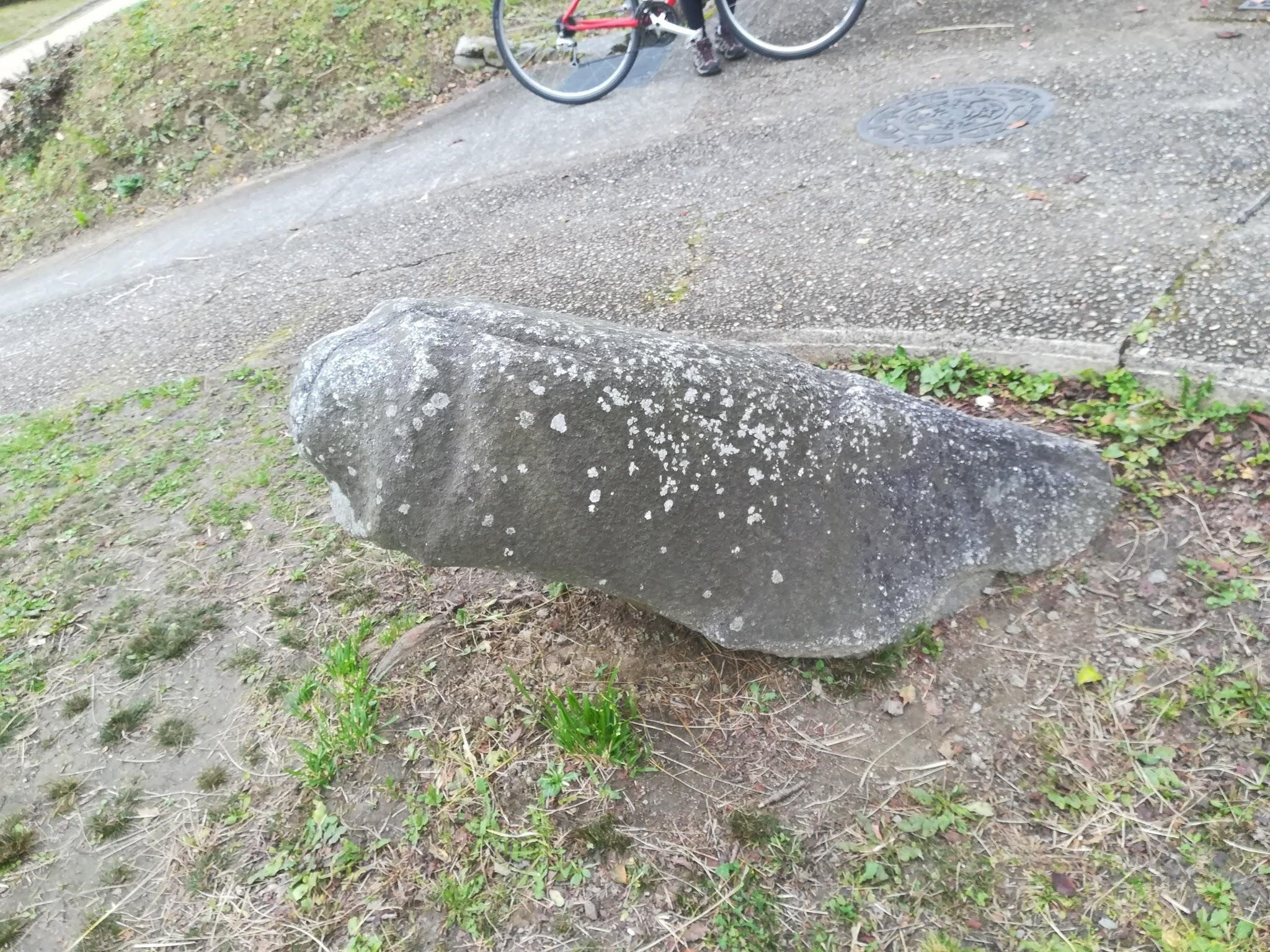
The Mara-ishi.
I found that the way all of the stones seemed to be scattered about, located next to rice fields, between homes of next to sidewalks also contributed to the everyday life feel of Asuka’s history, which was an aesthetic I really appreciated. What I considered to be priceless artifacts of history seemed to be taken at face value here and treated as living history, the locations the ancestors put them in preserved and respected, even if the reasons all remain a mystery.
Our tour did not just cover old monolithic stones (as much as I would have enjoyed that personally), but also other, less mysterious history was on the agenda, including the foundations of the old palaces of the first capital and Buddhist temples as well. In regards to the palace sites, not much remained of them beyond outlines of the foundations, but giving them a quick visit was still interesting as you can get an understanding of what the ancient people of Japan were thinking was ideal real estate some 1400 years ago, as well as a first-hand understanding of the size of the structures.
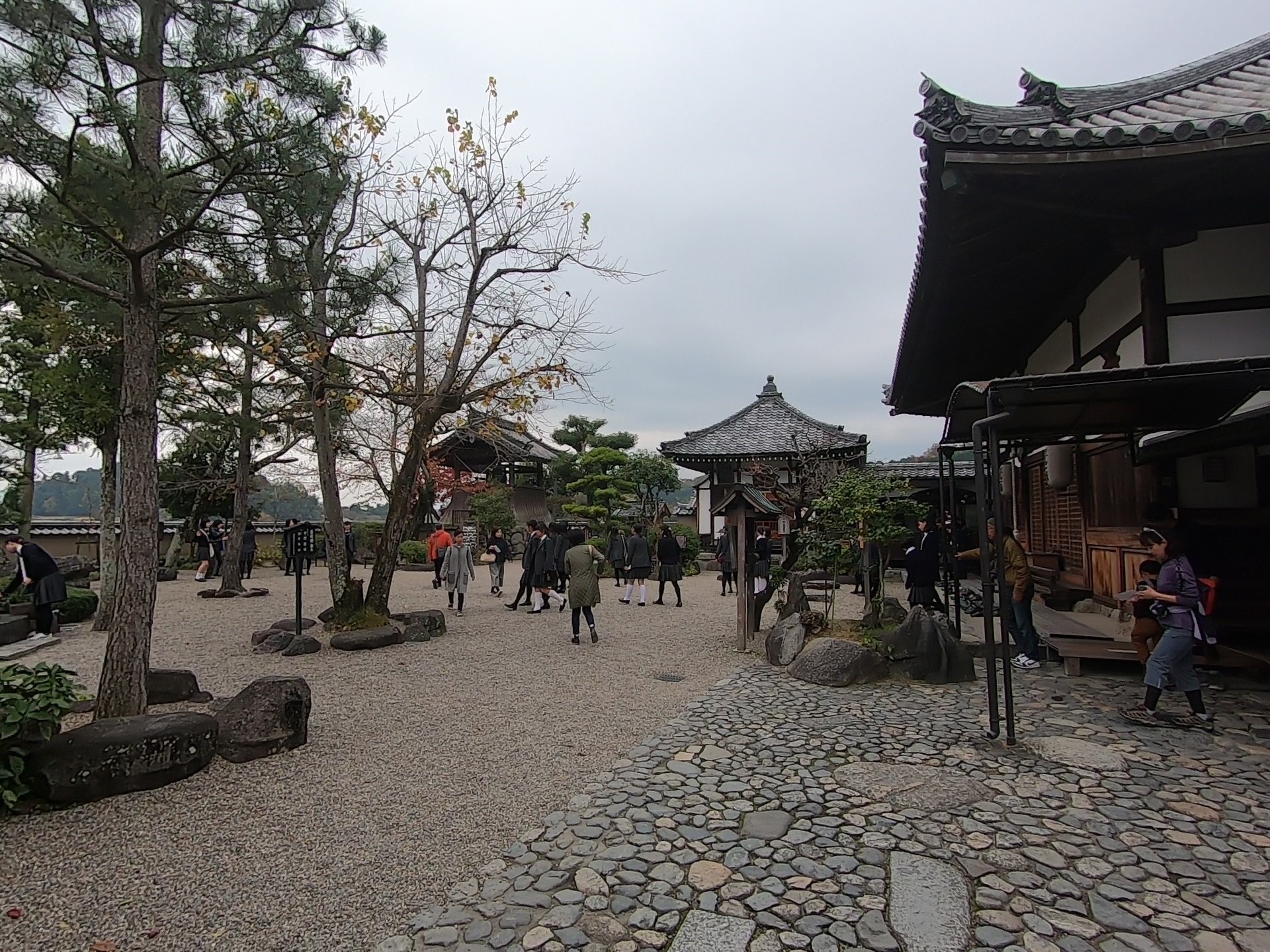
Asuka-dera Temple
One of the most interesting places we visited was the previously mentioned Asuka-dera Temple. While not containing the oldest Buddhist structures in Japan, this temple is believed to actually be the first established temple in the country after the faith was introduced to Japan through the Korean peninsula in the 6th century. Compared to many other temples in the country, Asuka-dera appears to be rather simple, which is actually an accurate preservation of what Buddhism was like in early Japan before it became much more esoteric over time.
In the main hall of the temple is a giant Buddha statue which has a different presentation style than that of many other main Buddhist temples that there is almost no distance between the worshipper and statue itself. This, as I was told, demonstrates how the relationship between the worshipper and the Buddha was much more direct at the time. As Buddhism changed and branched out, (influenced by great teachers such as Kukai, who promoted esotericism) the statues of Buddhas were often placed farther back in the temples, and in many cases, were completely hidden from view. So, next time you visit a Buddhist temple in Japan, try to look for the location of the main Buddhist statue of worship (in the main hall); in most cases, you will probably find it located pretty far from where you stand compared to Asuka-dera Temple.
Outside of history, our guide also took us to a great restaurant for lunch. Asuka has a surprising amount of very high quality restaurants that use fresh ingredients which are often harvested directly from farms in the region. There are also various unmanned booths around that sell fresh fruits and veggies based on the honor system, which was quite the shocker for this cynical American to see the first time around. I happily bought a big bundle of oregano for myself from one of these stores for 100 yen (about 1 US dollar), which I thought was quite a steal. There is also a road station, or Michi-no-eki, which serves a sort of farmer’s market, located just across from Asuka Station that has different seasonal goods on sale that is worth the time to check out as well. More on michi-no-eki locations in Nara here.
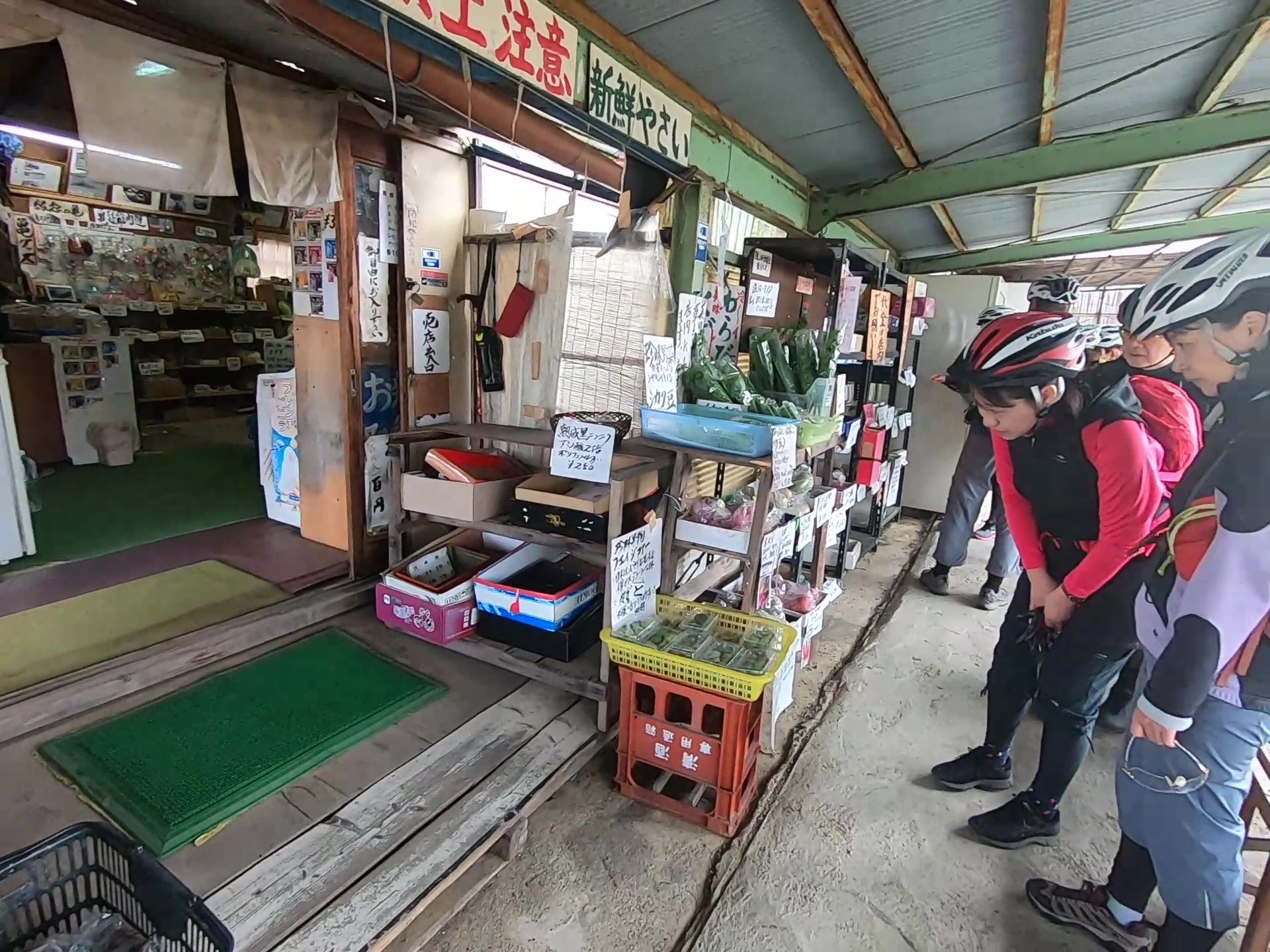
A shop selling locally grown food
Overall, I thought the experience provided by Niwa Cycling Tours was quite satisfying, covering a range of different historical points of significance as well as modern goodness. We visited other points I did not cover in this article, including Ishibutai Tomb, Amakashi Hill, and the Inabuchi Tanada Terraced Rice Fields (the scarecrow design contest that happens every year in Inabuchi Tanada is a highly recommended event), but I’ll leave that to you to discover on your own.
The joy of exploring has always been the biggest appeal of touring Asuka on a bicycle, and I think everyone should try to experience it for themselves, regardless of whether or not they care a lick about history. As you can tell from what I spent the most time on in this article, my favorite sightseeing aspect of Asuka was seeing the different monolithic stone designs. The fact is, Asuka is a very beautiful area worth your time for a variety of different reasons, and it is not too difficult to reach from cities like Nara and Osaka. So, you don’t really have an excuse for why you cannot visit Asuka. So get out there and explore the origins of Japan in Asuka Village, it is truly a fascinating landscape of living history.
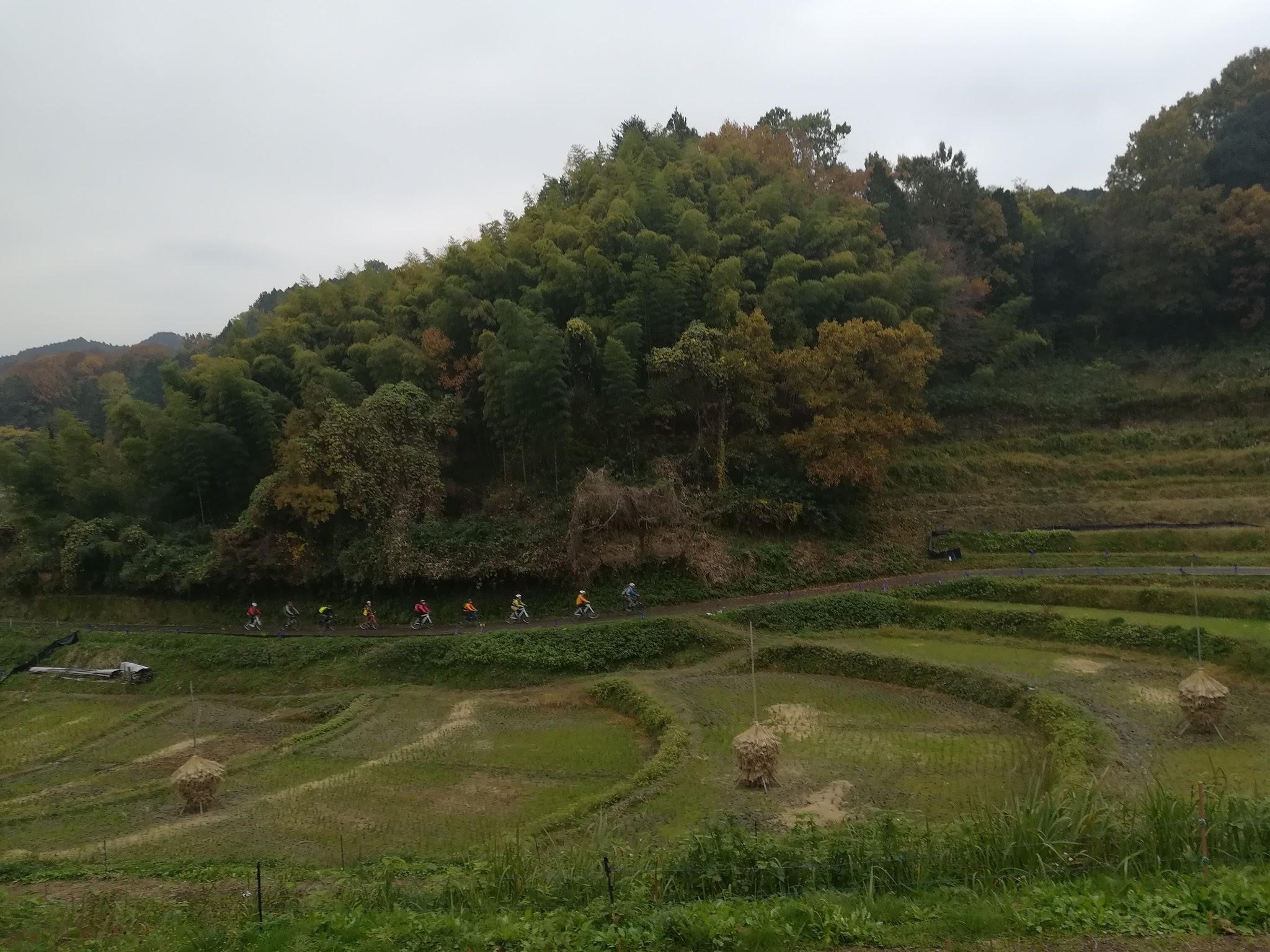
The beautiful Inabuchi Tanada area of Asuka.

